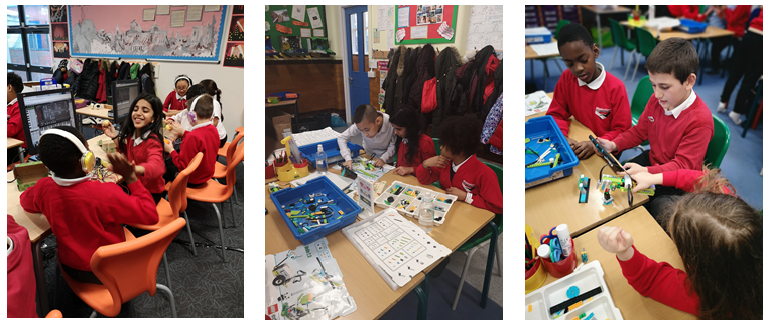Computing

What does Computing look like at Mission Grove?
Computing is an exciting subject and the curriculum at Mission Grove enables children to learn about the challenges and opportunities offered by the technologically rich world in which they live. The skills and knowledge gained in this subject allow pupils to solve problems, design systems, and understand the power and limitations of human and machine intelligence. Most importantly, Computing inspires curiosity, creativity, collaboration and resilience in pupils; ensuring they are better prepared for today’s world and the future.
As Computing has deep links with mathematics, science and design and technology, pupils need to have opportunities to use computer based technologies and methods in the real life contexts. This is why as well as the subject being taught as a separate lesson in the weekly timetable, opportunities for learning also happens through special trips and events such as S.T.E.M, Humanities and Film Week, which provide the pupils with the chance to put their skills and knowledge into meaningful, real-world contexts.
We have a fantastic range of resources which enrich learning and encourage excellence in the subject. Some of these include:
- Green Screen equipment
- The School radio
- Lego Wedo
- Cameras
- Espresso Coding
- Scratch
- Video editing software
Click here to read our Intent, Implementation and Impact statements.

EYFS
For our youngest learners in the foundation stage, we aim to give children a broad, play-based experience of computing in a range of contexts, including outdoor play. A wide range of computing takes place in discrete and unplugged activities, often through role play. Children have access to ipads, cameras, BeeBots and Spheros. They also have large range of electronic resources in their play environment, such as telephones, keyboards, computer monitors, toasters, kettles etc. which are used to role-play. We use topics and themes to encourage computational thinkings, allowing children to create links between different ideas and concepts. Computing in the EYFS is supported and supplemented by Barefoot Computing scheme.
KS1 and KS2
Pupils have access to a huge range of computing resources, including class sets of Chromebooks, digital cameras, ipads, green screens, radio, Lego WeDo, MicroBits and BeeBots. Computing lessons are taught once a week for 45 minutes each and are digitally evidenced on Google Sites. Lessons and activities are supported by the Teach Computing scheme of work which lays out a range of exciting and practical lessons for pupils.
Google Computing Sites
Computing lessons and activities are recorded on class google sites pages. Pictures, videos, screenshots and blogs are collected and recorded on each class page weekly.
Current 2023-2024 Computing Sites:
Check out our Google Computing Sites for Spring 2 2024 term here.
Check out our Google Computing Sites for Spring 1 2024 term here.
Check out our Google Computing Sites for Autumn 2 2023 term here.
Check out our Google Computing Sites for Autumn 1 2023 term here.
2022-2023 Computing Sites:
Check out our Google Computing Sites for Summer 1 2023 term here.
Check out our Google Computing Sites for Spring 2 2023 term here.
Check out our Google Computing Sites for Spring 1 2023 term here.
Computing Strands
The Computing Curriculum is divided into three strands; Computer Science, Digital Literacy and Information Technology. Although it is important to understand what the individual strands are, in practice, they are interwoven and taught seamlessly throughout the curriculum, as well as through discrete lessons.
Computer Science
The Computer Science strand is about using computational thinking to solve problems and make things for a purpose. Computational thinking is breaking down a task into smaller, easier to understand problems which can be solved. It generally, but not always, involves writing programs and helps children to develop their logical reasoning skills to gain an understanding of how computers think and carry out tasks.
Information Technology
The Information Technology strand is split two parts. The first part is teaching pupils to understand how information of all kinds becomes accessible and can be manipulated by technology. The core idea learnt is how information can be digitised and what the consequences of this might be. The second part is that children are able to use, express themselves and develop their ideas – at a level suitable for the future workplace and as active participants in a digital world. This is taught in largely in a thorough other subjects and allows children to experience a variety of different information technologies.
Digital Literacy
The Digital Literacy strand is split into two parts. One of these is about the safe and responsible use of technology. The other is about solving problems and making useful things through the use of digital tools, such as spreadsheets, video editing applications and so on. This area also teaches children about the opportunities to communicate and collaborate which are offered by computers and technology.
E-safety
A large part of Digital Literacy is also E-Safety; something very important at Mission Grove. We promote its importance every year in line with Safer Internet Day. Please visit the E-safety section on the website to find out more about what we do at Mission Grove and how you can help your child to stay safe online and when using technology. E-safety is taught discreetly every week, sometimes separately to computing lessons and often with links to other subjects such as PSHE and Literacy. Lessons and activities are supported by Project Evolve.
Parent Online Safety
We have created a page for our parents which is dedicated to keeping our children safe online. Keep up to date with the latest trends and recognise warning signs before they get out of control! Click here to visit the parent page.















